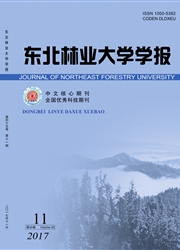

 中文摘要:
中文摘要:
以小兴安岭阔叶红松林林隙为研究对象,在对其形状和大小进行量化的基础上,对林隙内及其附近林分的光量子通量密度(DPPF)进行了连续的定位观测,分析了其时空分异特征。结果表明:3个不同大小林隙的面积分别为G1(528.13 m2)、G2(295.17 m2)、G3(83 m2),形状指数分别为1.524、1.455、2.146。每个林隙中心及林隙边缘各点光量子通量密度均为单峰型的日变化,呈南-北、东-西方向上的不对称分布。各时刻光量子通量密度的大小顺序分别为DPPF G1>DPPF G2>DPPF G3。3个不同大小林隙光量子通量密度最大值出现的时间和空间均存在差异。各林隙中心月平均光量子通量密度与林外光量子通量密度的比例分别为59.46%、35.34%、17.71%,林内和林隙有显著的季节性变化。林隙光量子通量密度在时间和空间上的变化是一个复杂的过程,由于林隙面积、形状和所处地理位置等的不同,各地观测结果不尽一致,探讨其时空分布特征需要进行长期深入连续的观测。
 英文摘要:
英文摘要:
After quantifing the shape and size of different size forest gaps in the mixed broad-leaved Korean pine forest in Xiaox-ing’an Mountains and measuring the photosynthetic photon flux densities (DPPF) in and around gaps, we studied the spa-tial and temporal distribution characteristics of DPPF.The area was G1 (528.13 m2), G2 (295.17 m2), and G3 (83 m2). The shape indexes were 1.524, 1.455 and 2.146, respectively.The diurnal variations of DPPF at the center edge of the three gaps presented a single peak curve , DPPF distribution was dissymmetry in the orientations of south-north and east-west.The value order of DPPF at each corresponding moment was G 1〉G2〉G3.The maximum DPPF of spatial and temporal appeared variation in different position in three gaps.The mean monthly DPPF of the center to the outside of G1, G2 and G3 were 59.46%, 35.34%and 17.71%, respectively.There was pronounced seasonal variation of DPPF in the forest and gaps sites.Spatial and temporal variation of DPPF was complex process, affected by the gap size, shape and topography, and the gap location. Therefore, we should take further long-term search and continuous observation on the spatial and temporal distribution characteristics of light .
 同期刊论文项目
同期刊论文项目
 同项目期刊论文
同项目期刊论文
 期刊信息
期刊信息
